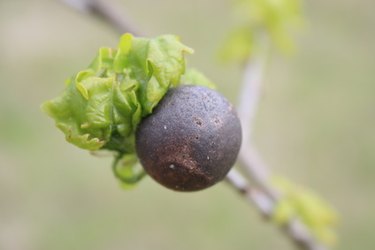
It is well-known that oak trees (Quercus spp.) produce their seeds in the form of acorns. However, you may have noticed small purple berries or sometimes brown berries hanging from oak tree branches as well. These peculiar purple berries on oak trees are actually not berries at all. Rather, they are galls that occur as a reaction to parasitic wasps and other creatures that lay their eggs on the tree's branches or leaves.
Tip
The purple berries you see on oak trees are most likely oak galls, which are not berries at all.
Video of the Day
What Are Oak Galls?
There are several kinds of oak galls, all varying in appearance. Some are purple, others are tan and some are even horned. Oak galls often form when the female gall wasp lays her eggs in the leaf's central vein, though this is just one variation on their provenance. Some wasps lay their eggs under the bark of the branches.
Video of the Day
When the larvae hatch, they release a crucial chemical and hormone interaction that causes the oak tree to forms the galls, which provide a home and nutrients for the developing wasp during the summer. Each gall contains a single wasp.
At first, the galls will appear green with brown spots and will feel rubbery, but they will then grow in size and change color as the wasp grows. Eventually, the gall will dry out, and the wasp will leave through a small hole and fly away in the summer or the following spring.
Other Causes for Galls
Galls can also be caused by fungi, bacteria, nematodes and mites, but insects like wasps are the more common culprit. Most often caused by cynipid wasps, the species of wasp creating the gall is specific to the oak tree species; however, they all share similar life cycles.
While sometimes unsightly, oak galls are not harmful to established oak trees. Occasionally, a heavy oak gall infestation may cause deformities in the leaves or stems or may cause early leaf drop. However, oak galls rarely lead to the death of the oak tree.
Oak Gall Treatment
While oak galls do not usually harm the tree, removing oak galls could possibly decrease future infestations. However, remember that there is no tried and true method to prevent oak galls from forming, and usually, the best stance to take is to ignore them. To remove oak galls, you can try pruning the small infected branches and twigs. Remove the infected areas with an anvil pruner for smaller branches and a lopper or a pruning saw for larger branches. Once removed from the tree, burn or crush the galls to kill the larvae inside and then discard them.
You can also decrease the likelihood of possible future infestations by clearing fallen leaves and twigs since many gall-producing insects like to overwinter beneath the debris. Increasing the gall-producing insects' natural predators, such as birds, could also decrease the risk of future infestations. Try hanging bird feeders from the tree since there are at least 24 bird species that eat wasps.
Lastly, if you are still concerned about an infestation, spray an insecticide containing carbaryl during early spring. This will stop the female wasps from laying their eggs. WD-40 could even help prevent an infestation of wasps. Be sure to follow the product instructions for proper usage and safety precautions.